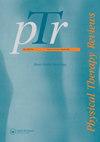Effects of dry needling on muscle spasticity in adults with neurological disorders: a systematic review
IF 0.8
Q4 REHABILITATION
引用次数: 1
Abstract
Abstract Background Spasticity is a motor disorder often associated with decreased ROM, ADL performance, and QOL. DN has shown potential to improve spasticity by stimulating spastic muscle tissue with a stainless steel monofilament needle. Objective To determine the effects of dry needling (DN) on muscle spasticity in adults with neurological disorders. Methods Literature search of Cochrane, CINAHL, Google Scholar, and ProQuest was conducted. Search limits: English, journals, human subjects, 2009–2019. Selection criteria: Adults 18+ with neurological disorders and interventions included dry needling as treatment for spasticity. Two reviewers, for methodological quality based on Oxford Levels of Evidence, independently assessed each study. Results Ten articles met the selection criteria, all showing reductions in spasticity. Secondary outcomes were reported with improvements at the impairment level including muscle length, range of motion, pain, and motor performance (Fugl-Meyer motor subscale); and at the functional level including hand dexterity (box and block test), balance (computerized dynamic posturography) and mobility (TUG). Conclusions There is low to moderate evidence in support of using DN to decrease spasticity in adults with neurological disorders, specifically in those with a history of stroke. Limitations included lack of follow-up and small sample sizes. Further high-level research is required to determine long-term outcomes of DN in spastic muscles. There was a short-term decrease in spasticity of target muscles after the performance of DN. Evidence included improvements at the impairment and functional levels after the use of DN. DN poses as a safe, feasible option to improve spasticity and impact other targeted outcomes in adults with neurological disorders.干针对神经系统疾病患者肌肉痉挛的影响:一项系统综述
背景痉挛是一种运动障碍,通常与ROM、ADL表现和生活质量下降有关。DN已显示出通过不锈钢单丝针刺激痉挛肌肉组织来改善痉挛的潜力。目的探讨干针疗法对成人神经系统疾病患者肌肉痉挛的影响。方法检索Cochrane、CINAHL、谷歌Scholar、ProQuest等文献。检索范围:英文,期刊,人类受试者,2009-2019年。选择标准:18岁以上患有神经系统疾病的成年人,干预措施包括干针治疗痉挛。根据牛津证据水平的方法学质量,两名审稿人独立评估了每项研究。结果10篇文章符合入选标准,痉挛症状均有所缓解。次要结果报告了损伤水平的改善,包括肌肉长度、运动范围、疼痛和运动表现(Fugl-Meyer运动量表);在功能层面,包括手的灵活性(盒子和积木测试),平衡(计算机动态姿势记录)和机动性(TUG)。结论:有低到中等程度的证据支持使用DN来减少成人神经系统疾病患者的痉挛,特别是那些有中风史的患者。局限性包括缺乏随访和样本量小。需要进一步的高水平研究来确定DN在痉挛肌肉中的长期预后。在DN表演后,目标肌肉的痉挛度有短期下降。证据包括使用DN后损伤和功能水平的改善。DN是一种安全、可行的选择,可以改善成人神经系统疾病患者的痉挛和影响其他目标结果。
本文章由计算机程序翻译,如有差异,请以英文原文为准。
求助全文
约1分钟内获得全文
求助全文
来源期刊

Physical Therapy Reviews
REHABILITATION-
CiteScore
1.30
自引率
0.00%
发文量
26
期刊介绍:
Physical Therapy Reviews is an international journal which aims to publish contemporary reviews, discussion papers and editorials within physical therapy, and in those basic and clinical sciences which are the basis of physical therapy. The journal is aimed at all those involved in research, teaching and practice within the area of physical therapy. Reviews (both descriptive and systematic) are invited in the following areas, which reflect the breadth and diversity of practice within physical therapy: •neurological rehabilitation •movement and exercise •orthopaedics and rheumatology •manual therapy and massage •sports medicine •measurement •chest physiotherapy •electrotherapeutics •obstetrics and gynaecology •complementary therapies •professional issues •musculoskeletal rehabilitation
 求助内容:
求助内容: 应助结果提醒方式:
应助结果提醒方式:


